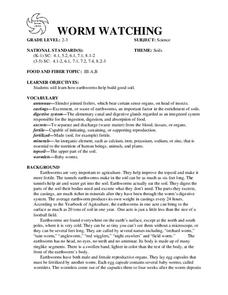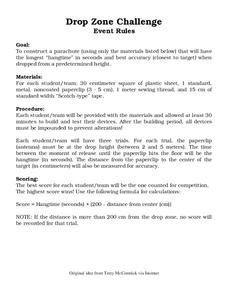Cornell University
Insect Anatomy
Young entomologists discover insect anatomy in a very detailed unit plan. Offering background information for teachers about various insects, class members explore the differences between bugs and insects—and yes, there are many...
Teach Engineering
Wimpy Radar Antenna
The Diary of a Wimpy Antenna? In the last installment of a six-part series, your class constructs a model of a radio antenna and tests its torque. Pupils use the results to design a better model that resists bending and twisting forces.
Curated OER
What's Bugging You?
Second graders investigate insects. In this parts of a whole, 2nd graders discuss what the three body parts of an insect are as well as the antenna. Students create their own insect labeling each body part and antenna.
Curated OER
Buzzing Bee's Wardrobe
Students investigate the anatomy of honeybees. In this anatomy lesson, students research the physical characteristics of bees and discover what they do. Students create a model of a honeybee showing the correct anatomy.
Curated OER
Insect Anatomy
In this insect worksheet, students label the parts of an insect on a diagram and then write down one fact about each of the body parts. This worksheet has 5 fill in the blank and 6 short answer questions.
Curated OER
WORM WATCHING
Students investigate how earthworms help build good soil. They examine the worms carefully to find the ringlike segments and swollen band at the front of the earthworm's body. Students take turns dampening the soil every day and adding...
Curated OER
"The Aquatic Fish Foods"
In this insects worksheet, students access a website to answer questions about the different types of insects that are food for fish. This worksheet has 10 short answer questions.
Curated OER
Arthropods
In this arthropods worksheet, students complete a graphic organizer by reading characteristics of the different classes or subphylum and writing in examples for each of these groups.
Curated OER
Identifying Organisms
In this organisms activity, 9th graders look at each picture of insects and use the key at the bottom of the sheet to determine which order they belong to. Then they explain which insect is a true bug and which is a true beetle and...
Curated OER
Drop Zone Challenge
In this physics instructional activity, students construct a parachute using the materials listed on the sheet that will have the longest and closest target when dropped from a specific height. Then they record their results after three...
Curated OER
Drop Zone Challenge
In this science challenge worksheet, learners construct a parachute that will have the longest time in seconds and best accuracy when dropped from a predetermined height. Then they use the formula given to determine the calculations.
Curated OER
Getting a Handle on Your Bee
Students observe dried bees, carefully glue them to toothpicks, and use them for cross pollinating their Brassica plants. They also describe reasons why two similar investigations can produce different results. Finally, students...
Curated OER
What's That You're Saying Out There?
Students are able to demonstrate knowledge of natural and artifical satellites. They are able to demonstrate the differeence between "active" and "passive" communciation. Students are able to define radio waves, amplification reflection,...
Curated OER
Mayfly and Stonefly Comparison Chart
In this insects worksheet, learners complete a graphic organizer by comparing the body structure of the mayfly and stonefly nymphs and adults. Then students draw each one.
Curated OER
World of Insects
For this biology worksheet, students identify and locate various vocabulary terms related to the world of insects in the puzzle. There are 51 words to locate in the word search.
Curated OER
Insects
Students, through books, videos, and readings, explore characteristics of insects. In groups, they choose an insect to research. Students discover their insect's diet, how they move, and where they live. Afterwards, they use the facts...
Curated OER
Science: Bugs and Body Parts
Students determine the function of various insect parts they have observed. Using descriptive words, they explain the insects' characteristics and draw pictures of them. The instructional activity concludes with students writing short...
Curated OER
Termite Biology
Students explore the physical characteristics, distribution and habitat of termites. The lesson focuses on the termite as a social creature contrary to most other insects.
Iowa State University
Iowa State University: Entomology Image Gallery
This site provides an extensive collection of photographs of insects.
Other
Tom Moore, Mulrennan Research Center/ Mosquito
The first section describes the general characteristics of the mosquito
Earth Life
Earth Life: The Diplopoda (Millipedes), Introduction
Introduction to the physical characteristics of the diplopoda, the millipedes.
University of Kentucky
University of Kentucky: Bug Fun
This fun site is designed for teachers who want to have interactive fun in the classroom. "Several articles give resources and basic information about insects and their relatives while others outline activities with different insect...
Other
Natural Aquariums: Arthropods
A brief description of the worlds most diverse phylum, the arthropods. General physical characteristics and body structure.
























